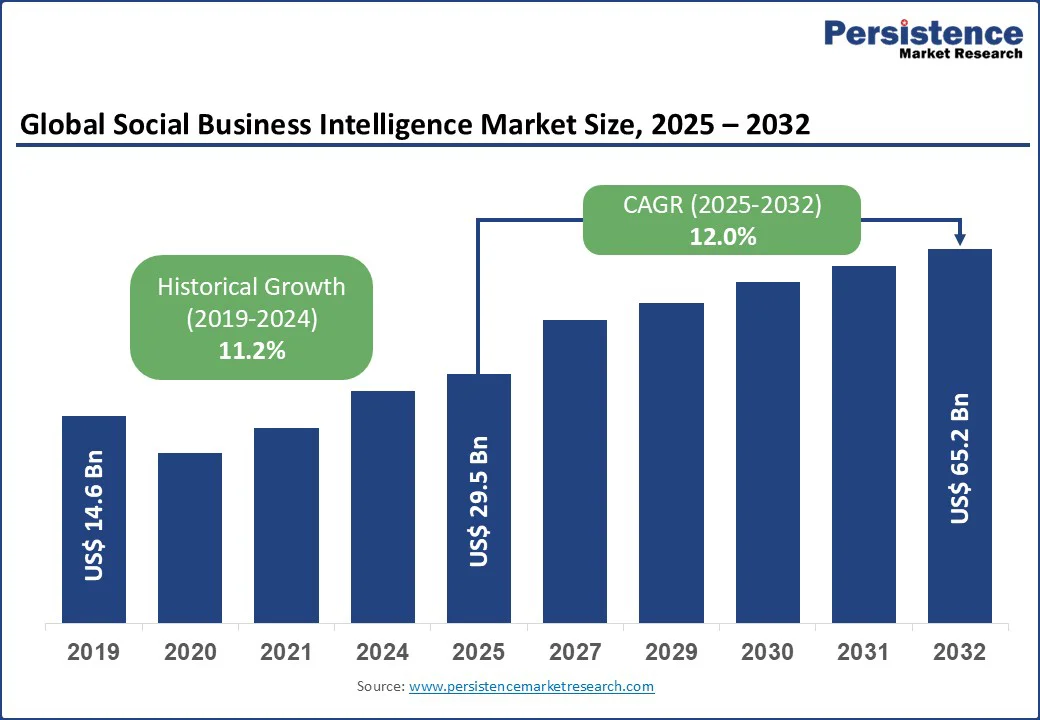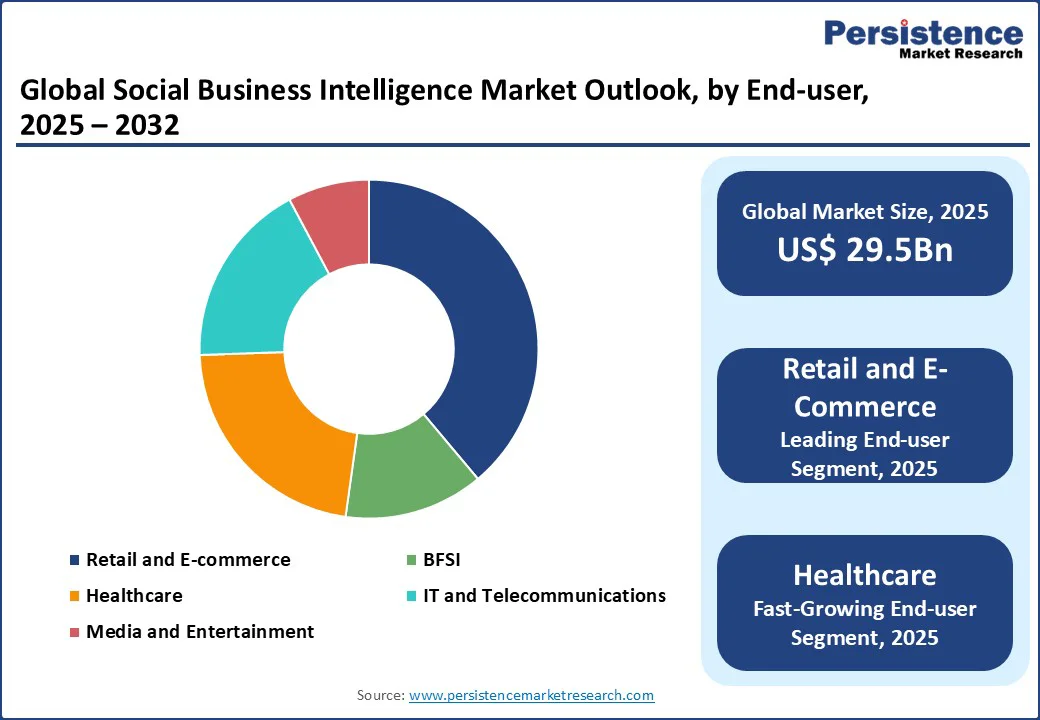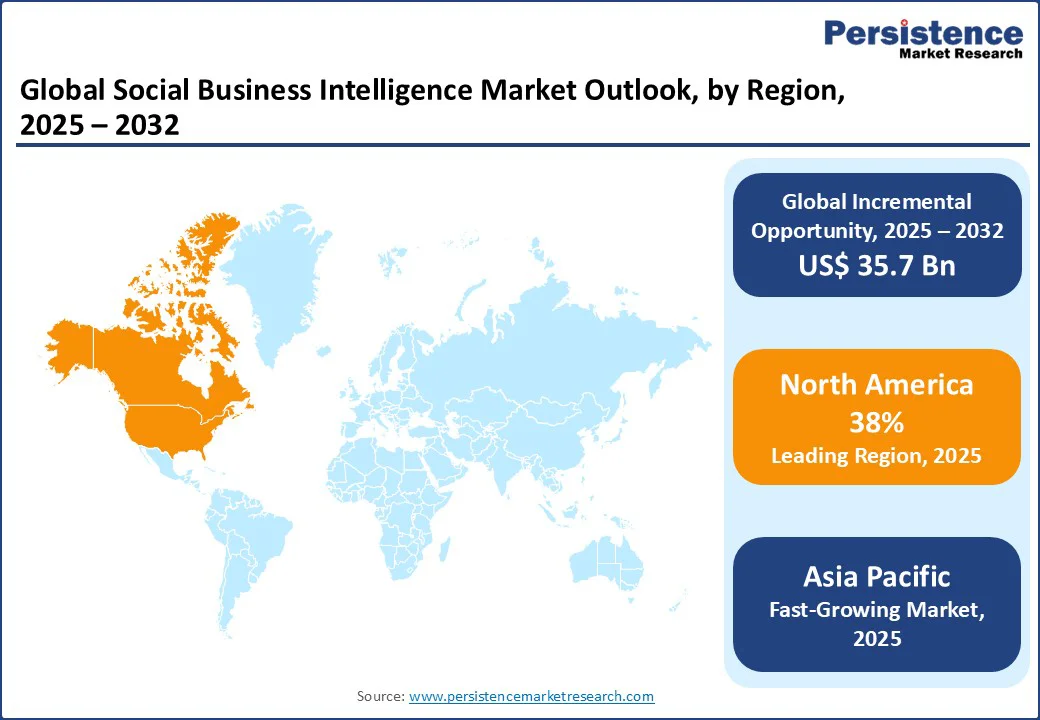ID: PMRREP12595| 196 Pages | 17 Sep 2025 | Format: PDF, Excel, PPT* | IT and Telecommunication

The global social business intelligence market size is likely to be valued at US$29.5 Bn in 2025 and expected to reach US$65.2 Bn by 2032, registering a CAGR of 12.0% during the forecast period from 2025 to 2032 driven by the rising demand for data-driven insights from social media, advancements in analytics technologies, and increasing need for real-time business decision-making solutions.
Key Industry Highlights:

|
Key Insights |
Details |
|
Social Business Intelligence Market Size (2025E) |
US$29.5 Bn |
|
Market Value Forecast (2032F) |
US$65.2 Bn |
|
Projected Growth (CAGR 2025 to 2032) |
12.0% |
|
Historical Market Growth (CAGR 2019 to 2024) |
11.2% |
The global surge in digital transformation and social media usage is a primary driver of the social business intelligence market. With data generation from social platforms growing rapidly, businesses increasingly rely on analytics to derive actionable insights for competitive advantage. This rising demand, particularly in sectors with high customer interaction and data volume, underscores the need for effective social business intelligence tools, which provide real-time sentiment analysis, trend forecasting, and customer behavior profiling to enhance decision-making. Companies using social intelligence are able to improve marketing effectiveness through targeted campaigns based on user data.
The e-commerce sector has seen strong adoption of these tools, where social business intelligence helps in predicting purchase patterns and optimizing inventory. Consumer engagement with brands on social media further drives the need for tools that analyze engagement metrics. In addition, IT and telecom applications benefit from advanced algorithms, which play a significant role in reducing churn rates through predictive analytics. Regions with high internet penetration, such as North America, have shown rising investments in analytics software, directly correlating with social business intelligence demand. Technological advancements in AI and machine learning integration have also shortened analysis time, making it more accessible for real-time applications and further fueling growth.
The industry faces notable restraints, primarily driven by the elevated costs associated with implementing advanced software integration and managing vast amounts of social data. Since social media data sources are highly diverse and continuously expanding, businesses are required to invest heavily in storage and processing infrastructure. These expenses create barriers, especially for organizations with limited financial resources. Beyond infrastructure, the demand for skilled professionals capable of managing complex analytics platforms, including AI-driven sentiment analysis engines, further raises operational costs. Smaller enterprises often struggle to compete in this space due to the lack of expertise and budgetary constraints.
Additionally, strict regulatory requirements surrounding data privacy and compliance, such as global standards for user protection, add another layer of complexity. These factors become particularly challenging in emerging markets, where regulatory knowledge and technical expertise may lag, collectively slowing down the widespread adoption of social business intelligence solutions.
Innovations in AI-integrated analytics methods and the growing expansion of multi-functional applications present substantial opportunities for the industry. Advancements in machine learning technologies, particularly natural language processing, are enabling organizations to extract more accurate and meaningful insights from unstructured data while significantly improving the speed of analysis. These innovations allow businesses to respond more effectively to shifting customer preferences and market dynamics. Beyond traditional commercial sectors, the versatility of social business intelligence is increasingly being recognized in new domains.
Governments are adopting these tools to track public sentiment and guide policy decisions, while the healthcare industry is using them to evaluate patient experiences, enhance service delivery, and strengthen communication between providers and communities. Such applications highlight the adaptability of social intelligence beyond corporate marketing. Furthermore, expansion opportunities in underpenetrated regions, including Latin America and the Middle East, offer immense growth potential as digital ecosystems mature and organizations seek advanced analytics capabilities to stay competitive.
The social business intelligence market is segmented into solutions and services, with solutions dominating and holding approximately 65% of the market share in 2025. This leadership is attributed to their cost-effective deployment, scalability for enterprise applications, and ability to deliver actionable insights efficiently across industries.
The services segment is the fastest-growing segment, driven by rising demand for customized implementation, ongoing technical support, and tailored analytics solutions. Organizations increasingly seek expert guidance to optimize tool deployment, enhance performance, and extract maximum value from their analytics investments.
The social business intelligence market is segmented into sales and marketing, customer service/support, operations, finance, human resources (HR), and product development/innovation (R&D). Finance dominates, holding approximately 38% of the market share in 2025, due to its essential role in risk management, fraud detection, and financial forecasting.
The customer service and support segment is the fastest-growing in the social business intelligence market, driven by an increasing emphasis on real-time feedback and rapid issue resolution via social channels. Businesses are leveraging these tools to enhance customer satisfaction, loyalty, and overall engagement.
The global social business intelligence market is divided into BFSI, retail and e-commerce, healthcare, IT and telecommunications, media and entertainment, and government and public sector. Retail and e-commerce leads with a 35% share in 2025, driven by its widespread use in consumer trend analysis and personalized marketing.
The healthcare segment is the fastest-growing in the social business intelligence market, driven by increasing adoption for monitoring patient sentiment, analyzing feedback, and improving service delivery. These tools help healthcare providers enhance patient experiences, optimize care processes, and strengthen communication across healthcare systems.

North America dominates the global social business intelligence market, expected to account for 38% of the market share in 2025, with the U.S. acting as the primary growth driver due to widespread technological adoption and innovation in data analytics. Social business intelligence has become a key component of strategies aimed at enhancing customer retention, improving brand management, and supporting market expansion. The rise of social media monitoring and real-time engagement tools allows companies to better understand consumer behavior, optimize campaigns, and respond quickly to market trends.
The U.S. market is also witnessing a strong shift toward AI-enhanced analytics tools, which improve insight accuracy, streamline data processing, and support proactive decision-making. Collaborations between technology leaders and major enterprises further strengthen the market by enabling deeper data integration and actionable intelligence. Canada contributes significantly as well, with growing demand for multilingual analytics, compliance-focused solutions, and tools tailored to regional regulatory requirements, collectively reinforcing North America’s leadership in social business intelligence adoption.
Europe holds a substantial position in the social business intelligence market, with countries such as Germany, the UK, and France driving growth through strong regulatory frameworks and a focus on consumer data protection. Germany leads the region due to its advanced manufacturing and technology sectors, which foster the availability of analytics tools and innovations in operational intelligence, supported by stringent EU data privacy regulations. The UK follows closely, with a robust demand for marketing intelligence and analytics solutions that help businesses optimize campaigns and better understand consumer behavior.
France contributes through the multi-functional adoption of social business intelligence in sectors such as media and entertainment, reflecting a cultural emphasis on consumer engagement and personalized experiences. Across the region, companies are increasingly leveraging AI-driven analytics and predictive tools to enhance operational efficiency, improve customer insights, and ensure compliance with evolving data protection standards, collectively strengthening Europe’s role as a key market for social business intelligence solutions.
Asia Pacific is the fastest-growing region in the global social business intelligence market, driven by leading countries such as China, India, and Japan. China leads expansion with its massive digital user base and rapidly growing e-commerce sector, creating strong demand for analytics tools that optimize marketing strategies, predict consumer behavior, and improve operational efficiency. India is witnessing increased adoption of mobile analytics solutions, as businesses leverage these tools to gain customer insights, enhance engagement, and support the growth of the digital economy.
Japan focuses on IT and telecom applications, where a tech-savvy population drives the need for advanced predictive analytics and AI-driven insights to improve service delivery and decision-making. Across the Asia Pacific region, companies are investing in innovative analytics solutions to capture emerging market opportunities, enhance competitiveness, and support digital transformation initiatives, collectively establishing the region as a hub for rapid growth in social business intelligence adoption.

The social business intelligence market is highly competitive, with both global and regional players striving to capture market share through innovation, reliable solutions, and competitive pricing. The growing adoption of AI-integrated and multi-functional tools intensifies rivalry, as companies work to meet evolving regulatory standards and enterprise requirements. Strategic partnerships, mergers, acquisitions, and compliance with regulations serve as key differentiators in maintaining market leadership.
The social business intelligence market is projected to reach US$29.5 Bn in 2025.
Rising digital transformation, advancements in social analytics, and initiatives for data-driven decisions are key drivers.
The market is poised to witness a CAGR of 12.0% from 2025 to 2032.
Innovations in AI-integrated analytics and multi-functional solutions present significant growth opportunities.
IBM Corporation, Microsoft, and SAP SE are among the leading players.
|
Report Attribute |
Details |
|
Historical Data/Actuals |
2019 - 2024 |
|
Forecast Period |
2025 - 2032 |
|
Market Analysis |
Value: US$ Bn Volume: As Applicable |
|
Geographical Coverage |
|
|
Segmental Coverage |
|
|
Competitive Analysis |
|
|
Report Highlights |
|
By Component Type
By Function
By End-user
By Region
Delivery Timelines
For more information on this report and its delivery timelines please get in touch with our sales team.
About Author